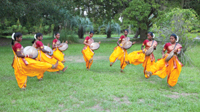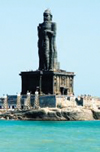|
By
Boobalan Pachaiyappan, Ph.D.
Pharmaceutical, Biomedical
Sciences
Maintaining
longevity is as much an art as a
science. Drugs taken to treat the
physical and chemical imbalance of
the body often end up being
futile, with side-effects or a
plethora of other complications.
In the
post-Genomic world that is filled
with numerous disease conditions,
advanced medical methods,
ultra-sharp instruments and
skilled physicians, the Siddha
system of medicine that still is
practiced in the South of India
almost has eluded attention.
 Sakthi dancers from
India perform Thappattam, a type
of dance while playing Parai, a
percussion instrument. The
dancers performed at the FeTNA
(Federation of Tamil Sangams in
North America) Convention at the
Gaillard Auditorium, July 2 - 4. Sakthi dancers from
India perform Thappattam, a type
of dance while playing Parai, a
percussion instrument. The
dancers performed at the FeTNA
(Federation of Tamil Sangams in
North America) Convention at the
Gaillard Auditorium, July 2 - 4.
Siddha
medicine, which dates back several
thousand years before the Common
Era (or A.D.), also is 'a perfect
medicine' and involves application
of products obtained from plants,
animals and inorganic substances
(metals and minerals) to treat
almost all ailments with minimum
or no side effects. Siddha
medicine has stood the test of
time and made impressive
contributions to global health
using indigenous resources.
The word,
Siddha (or Siddhars in Tamil),
refers to someone who attained
Siddhi or extraordinary powers. In
the present context, Siddha refers
to 18 prominent ancient
supernatural saints who achieved
extraordinary psychic powers
through years of fasting and
meditation. The roots of this
Siddha medicine are intertwined
with the ancient Tamil
civilization. Originally compiled
in palm leaves in the form of
short complex Tamil poems, the
system of Siddha medicine has been
a closely guarded secret that
eventually has been made public.
Siddha medicine also encompasses
yoga and Varma (proper application
of releasing stagnant energy from
vital points) therapy in order to
promote healing.
Only by keeping
the body healthy can one keep a
soul healthy. At least this is
what the Siddhars believed. They
also believed that the factors
that control the human body
(microcosm) are nothing but the
manifestations of the five
macroscopic elements (Iynkurukal
or Panja Bhutas) that control the
universe (macrocosm), namely
earth, water, air, fire and ether.
The Siddha
system of medicine recognizes the
synergistic role played by seven
physical constituents (plasma,
blood, muscles, fatty tissues,
bones, nerves, both male and
female hormones) and three life
force factors (air, bile and
phlegm) to maintain a healthy
state. An imbalance in the
equilibrium state of these 10
factors due to diet, physical
activity, stress and environmental
(cosmic) factors would result in
disease conditions. In the Siddha
system of medicine, enormous
emphasis has been given to
diagnostic methods in order to
identify the disease condition
before prescribing a cure. These
are called eight-fold diagnostic
methods (En Vagai Thervu), which
are based on inspection of tongue,
color, voice, eyes, touch, stool,
urine and pulse. A staunch
practitioner of Siddha medicine
can unambiguously identify the
disease condition based on these
inspection methods. For example,
the Siddha system of medicine
unambiguously diagnosed jaundice
by analyzing pulse at the radial
artery, inspection of a yellow
pigmentation in the white of the
eyes and early morning
saffron-colored urine, and
prescribes Phylanthus Niruri
(Kizhanelli) for a side-effect
free cure.
Another
interesting point to note about
the Siddha medicines is that they
can be administered in both
disease conditions (for
recuperation) as well as to health
conditions (prevention). A few
simple Siddha-based remedies are
listed below:
--The twigs of neem and banyan
trees are used for cleaning teeth.
The seeds and leaves of neem
(Vepam) have antiseptic,
antiviral, anti-inflammatory,
hypotensive and anti-ulcer
effects.
--Recent viral fevers in Tamilnadu
that were incurable with
conventional antiviral drugs were
successfully controlled using
extracts from neem and other
medicinal plants (Nilavembu
Kudineer).
--Fenugreek (Venthiyam) soaked in
water and taken with yogurt cures
chronic diarrhea and mucous
dysentery.
If there is one
concept that the Siddha medicine
reiterates, it is this simple
premise: "Food is medicine."
Siddha medicine infused medicinal
plants into traditional cooking
and formulated a regimen for
consumers in order to maintain the
holistic balance of the human
body. It benefits everyone to know
and take advantage of the Siddha
medicine that stands the test of
time.
Tamil Nadu
Facts
- Capital:
Chennai, formerly known as
Madras. Tamil Nadu, India's
cultural capital was formerly
known as Madras State and is
located in southeast India,
consisting of 30 districts.
- Language:
Tamil is the official language
of Tamil Nadu (as well as one of
the official of several hundred
languages of India).
- Festival:
Pongal is the most celebrated
four-day harvest festival of
Tamil Nadu, followed in
importance by Diwali.
- Landmark:
Thiruvalluvar statue is a 133
feet tall stone sculpture of the
Tamil poet and saint
Tiruvalluvar,
 author of the
Thirukkural. It is located atop
a small island near the town of
Kanyakumari, where two seas and
an ocean meet: the Bay of
Bengal, the Arabian Sea and the
Indian Ocean. The statue
standing on the pedestal
represents wealth and pleasure,
signifying that wealth and love
be earned and enjoyed on the
foundation of solid virtue. author of the
Thirukkural. It is located atop
a small island near the town of
Kanyakumari, where two seas and
an ocean meet: the Bay of
Bengal, the Arabian Sea and the
Indian Ocean. The statue
standing on the pedestal
represents wealth and pleasure,
signifying that wealth and love
be earned and enjoyed on the
foundation of solid virtue.
- Area:
130,058 sq km or 50,216 sq miles
- Industries:
The city of Tirupur is the
largest garment exporter in
India; Chennai is known as the
Detroit of India because of its
automotive industry.
Clinician's corner
Clinician's corner
A
12-year-old Indian female comes
in with shortness of breath for
the past two days. Her past
medical history is only notable
for fever with sore throat she
had four weeks ago.
During
her period of illness, she had
swelling of both knees, then
later her ankles, but that has
resolved. She also noted nodular
swelling on her back and elbow.
But they have resolved too. She
only took Tylenol for it as her
mother thought this was a viral
infection.
On exam,
she had significant wheezing and
the doctor said that she has
'murmurs' and ordered an echo.
Based on this history, what is
the most likely diagnosis of the
patient's illness?
A. Summer Flu
B. Malaria
C. Rheumatic Fever
D. Typhoid
Correct
Answer :C. Rheumatic Fever
This patient clearly suffered
from Rheumatic fever and now
has rheumatic heart disease.
Rheumatic fever (RF) is a
systemic illness that may
occur following group A beta
hemolytic streptococcal
(GABHS) pharyngitis in
children. Rheumatic fever and
its most serious complication,
rheumatic heart disease (RHD),
are believed to result from an
autoimmune response; however,
the exact pathogenesis remains
unclear.
|



 Sakthi dancers from
India perform Thappattam, a type
of dance while playing Parai, a
percussion instrument. The
dancers performed at the FeTNA
(Federation of Tamil Sangams in
North America) Convention at the
Gaillard Auditorium, July 2 - 4.
Sakthi dancers from
India perform Thappattam, a type
of dance while playing Parai, a
percussion instrument. The
dancers performed at the FeTNA
(Federation of Tamil Sangams in
North America) Convention at the
Gaillard Auditorium, July 2 - 4.
 author of the
Thirukkural. It is located atop
a small island near the town of
Kanyakumari, where two seas and
an ocean meet: the Bay of
Bengal, the Arabian Sea and the
Indian Ocean. The statue
standing on the pedestal
represents wealth and pleasure,
signifying that wealth and love
be earned and enjoyed on the
foundation of solid virtue.
author of the
Thirukkural. It is located atop
a small island near the town of
Kanyakumari, where two seas and
an ocean meet: the Bay of
Bengal, the Arabian Sea and the
Indian Ocean. The statue
standing on the pedestal
represents wealth and pleasure,
signifying that wealth and love
be earned and enjoyed on the
foundation of solid virtue.